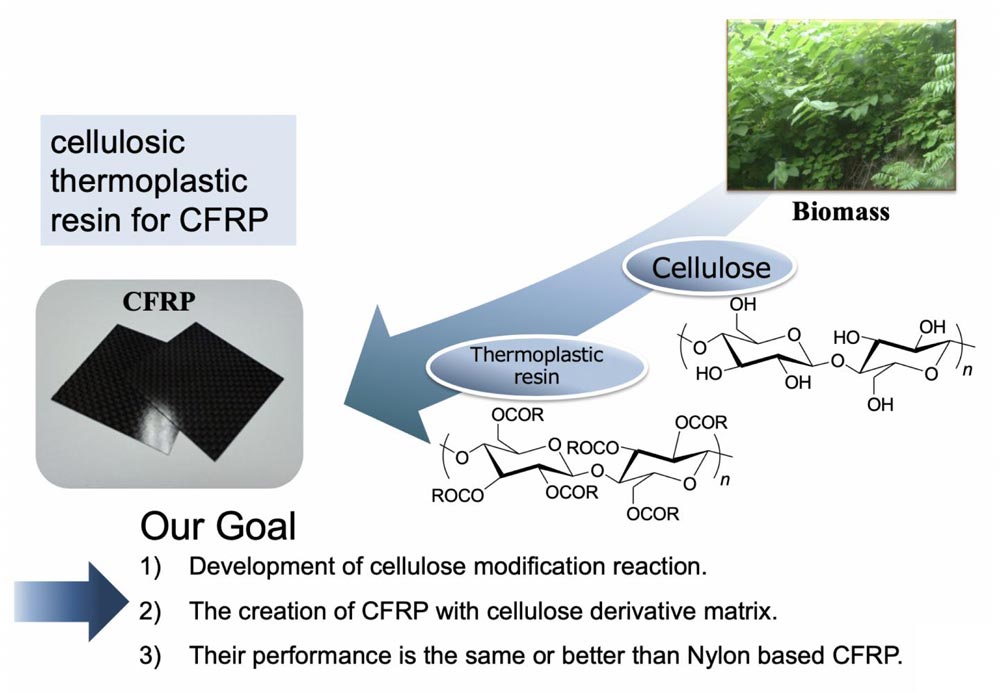

Carbon fiber reinforced plastic using cellulose based thermoplastic.
Credit: Kanazawa University
As a result, there is keen interest in optimizing the mechanical properties of short-fiber reinforced thermoplastics to maximize on the potential of these materials. László Szabó and Kenji Takahashi and colleagues at Kanazawa University and Kanazawa Institute of Technology have now demonstrated that irradiating short carbon fiber thermoplastics with an electron beam can improve their mechanical properties.
The researchers limited their study to polymers that thermoplastic so that the resulting composite could be readily recycled and remolded into other forms. With environmentally friendly concerns in mind they focused the study on the biobased cellulose propionate for the composite matrix.
Their study included investigation of the effects of electron beam irradiation on the strength for polymers functionalized with esters to increase crosslinking, and enhanced with carbon fibers, as well as different forms during irradiation (dumbbells and pellets) and long and short extrusion nozzles.
While the researchers were able to demonstrate a level of control over crosslinking under radiation with the use of functionalizing esters, this was not always beneficial for the mechanical properties, particularly when the network of polymers hindered the mobility of the fibers.
In addition, there is known to be a minimum carbon fiber length below which their inclusion compromises rather than enhances the tensile strength of the composite as their presence causes cracks.
Despite the potential drawbacks of carbon fiber inclusion and irradiation induced crosslinking, the researchers found that irradiating pellets of short-carbon-fiber composite made them stronger.
Further studies suggested that the irradiation strengthened and lengthened the carbon fibers, while irradiating pellets and making dumbbells from the pellets left sufficient uncrosslinked polymer matrix for some carbon fiber mobility to mitigate stresses. The shorter nozzle, also diminished effects that shorten carbon fiber during extrusion.
“The composite retains its potential for recyclability (i.e. still thermoplastic) and the treatment is practically chemical-free,” report the researchers. Future work may include further mechanical characterization of the material.
###
Background
1) Environmental benefits of carbon fiber reinforced thermoplastics
Lower mass materials require less fuel to move them, so that exploiting light weight properties of thermoplastics in automobile applications could decrease fuel requirements. In addition, thermoplastics can be processed easily from largely benign components making them more readily recycled.
Obtaining carbon fibers is also becoming increasingly sustainable, with reports of carbon fibers produced from lignin in biomass. As a result the use of carbon fibers to enhance the mechanical properties of thermoplastic polymers could provide an environmentally friendly material option for applications where mechanical stresses and strains experienced are moderate.
2) Irradiation and crosslinking
Irradiation leads to both chain scission and crosslinking effects in polymers. In cellulose propionate the chain scission greatly outweighs crosslinking. While functionalizing with esters could enhance crosslinking under irradiation, the researchers found that this actually diminished the tensile strength as the polymer became stiffer.
Adding carbon fibers can provide sites that initiate cracks. If the carbon fibers are long enough the overall effect is still a stronger material but for short carbon fibers, their inclusion can actually weaken the composite. In addition crosslinking in the polymer matrix can inhibit fiber mobility, so that stresses build up.
The researchers also found that extrusion can further shorten carbon fibers, an effect that a shorter extrusion nozzle can help to mitigate. Irradiation has a positive effect on carbon fiber strength and length by forming free radicals that form covalent bonds between planes in the graphitic fiber structure. As a result producing dumbbells from irradiated carbon-fiber-enhanced polymer pellets improved the material's mechanical properties; the irradiation led to stronger longer carbon fibers, and making the dumbbells from irradiated pellets led to some uncrosslinked matrix from the different pellets to allow fiber movement.












